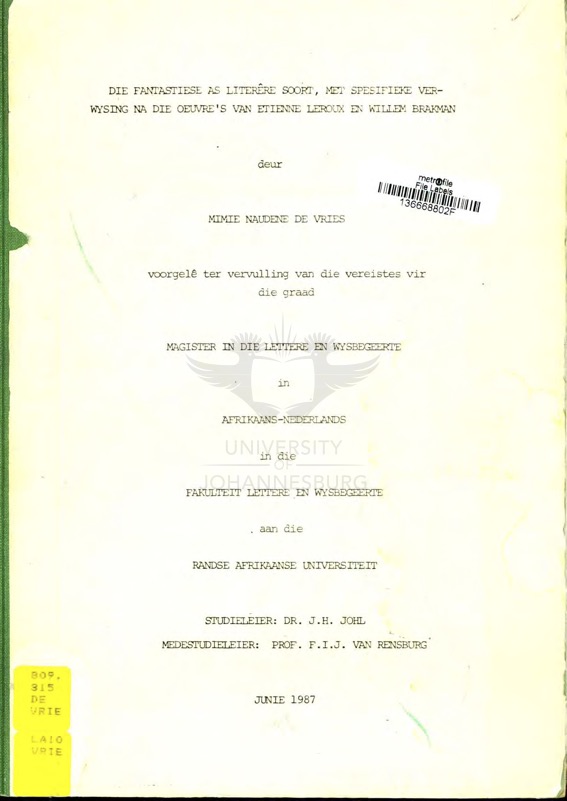-
Title
-
Die fantastiese as literêre soort, met spesifieke verwysing na die oeuvre's van Etienne Leroux en Willem Brakman
-
author
-
De Vries, Mimie Naudene
-
datePublished
-
1987
-
degree
-
Magister in Lettere en Wysbegeerte
-
publisher
-
Randse Afrikaanse Universiteit
-
department
-
Afrikaans-Nederlands
-
contributor
-
Johl, J. H.
-
Van Rensburg, F. I. J.
-
description
-
The purpose of this study is to determine the structural functioning of the fantastic element in the works of Etienne Leroux and Willem Brakman. Firstly, the concept of "the fantastic" is defined. The fantastic occurs when a non-rational and supernatural element appears in a work, involving a subversion of what is regarded as a "realistic" and normally "possible" frame of reference. The fantastic, however, operates with elements taken from a recognizable reality and can never be totally divorced from a reality assumed to be normal in at least some of its aspects. The abstract author may use different techniques of manipulation to bring about the subversion or transgression of the normal, realistic frame of reference. An overt and dramatic violation of normal assumptions about the real can take place, or extraordinary phenomena can be highlighted to the point of fantastic absurdity. Perspectival techniques of diminution and exaggeration, as well as a "super-realistic" description can transform some of the givens of a work so that they become fantastic. A fantastic element violating the realistic conventions can result in a transgression of normal categorial expectations about time, milieu and character. The fantastic does not always manifest itself with the same scope or degree of intensity; a scale of values and nuances may accordingly be set up for the appearance of the fantastic in literature. Even if entire work cannot be regarded as being completely "fantastic", the fantastic can still be present as an artistic technique dominating the discourse of the work of art. A salient correspondence between the works of Etienne Leroux and Willem Brakman is the psycho-analytical theories and philosophies that appear as a layer of meaning in both authors. The referential framework of Jung's psychology in Leroux's novels, and the Freudian of Brakman's prose determine in a significant way the structural appearance of the fantastic in their works, and form the basis for a comparative investigation. Prominent critics have indicated that Jungian psychology is the single most important field of reference in Leroux's work. Here the fantastic element is often manifested as an individual perspective on and interpretation of Jung's theories (although also, as has been found in this study, the fantastic can have complex relations with other features such as irony, satire, etc.). The fantastic touch has played an important part in the development of Leroux's oeuvre. In his first cycle of novels descriptions and details are to a large extent still realistic, but in the works following the fantastic element develops fully and enables the abstract author to treat and to develop gradually the same basic theme, without creating the impression of self-repetition. The fantastic creates unity between different levels of meaning, and fantastic scenes can operate as richly loaded symbols. The fantastic at the same time, as covering technique, enhances the suggestiveness of the symbols employed. Fantastic scenes in Brakman's work are often artistic representations of aspects of Freud's theories, specifically depictions of the psychical labyrinth in which the typical Brakman protagonist finds himself as a result of an Oedipal conflict. Brakman's comprehensive range of linguistic effects, often termed "baroque" by critics, allows him to achieve the fantastic dimension to excellent effect.
-
keywords
-
Brakman, Willem
-
Die fantastiese
-
Leroux, Etienne
-
Hilaria, 1957
-
Sewe dae by die Silbersteins, 1962
-
Na'va, 1972
-
Onse Hymie, 1982
-
Glubkes oordeel, 1967
-
Zes subtiele verhalen, 1978
-
inLanguage
-
Afrikaans
-
numberOfPages
-
179
-
fileFormat
-
PDF

